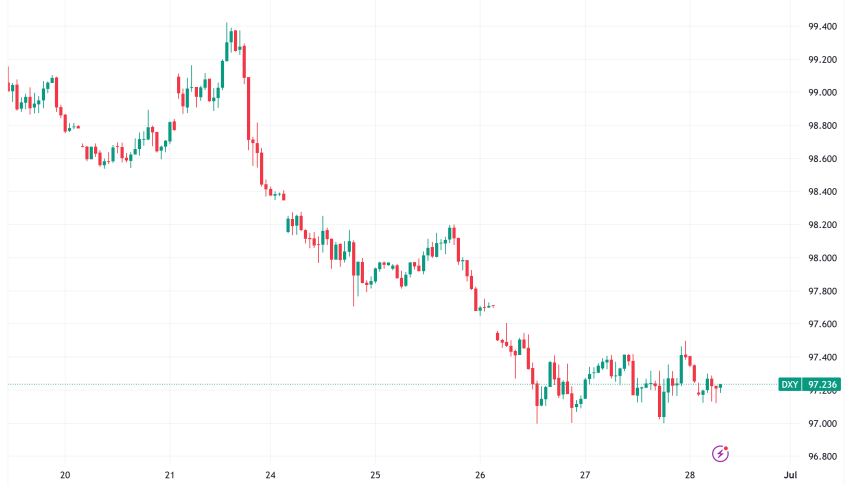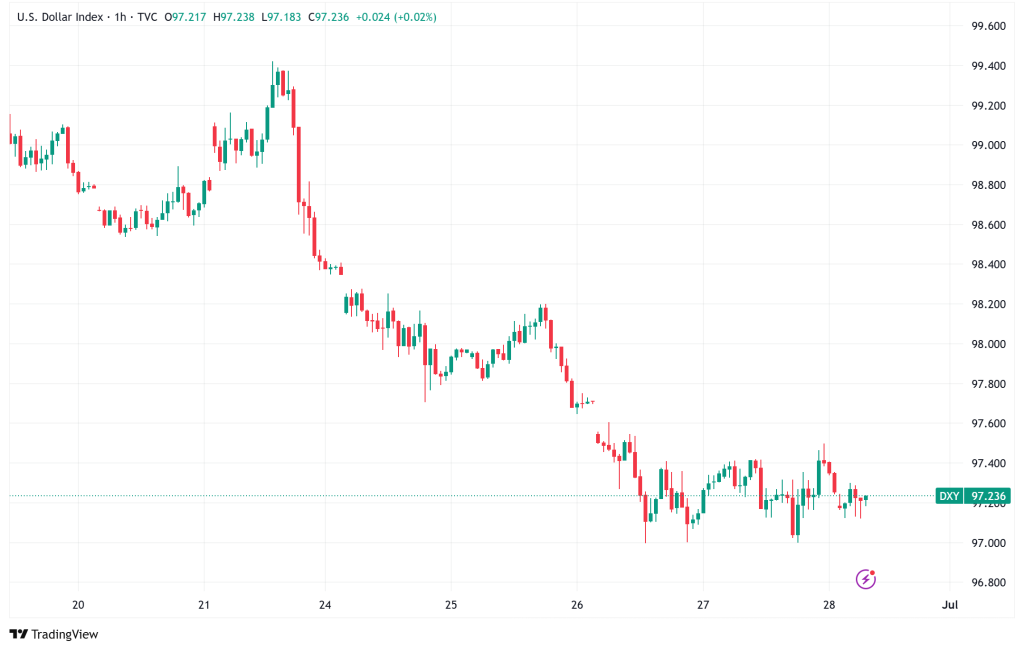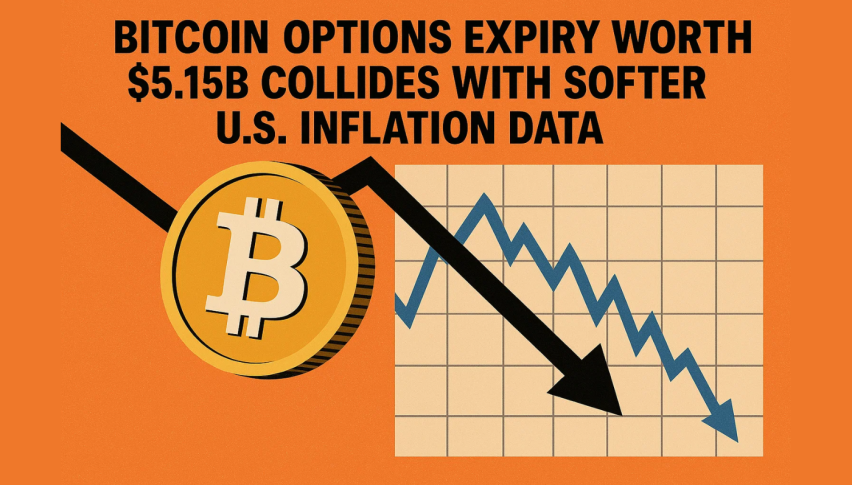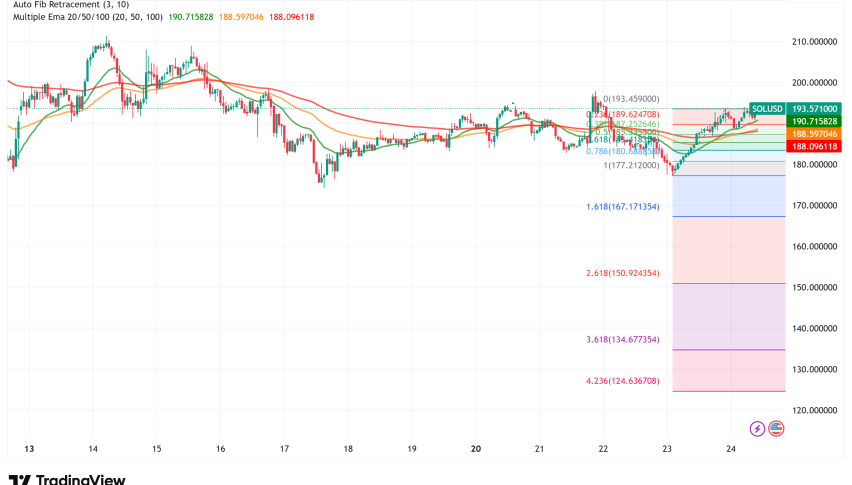US Dollar Index (DXY) Hovers Near Three-Year Lows, Faces Multiple Headwinds
The US Dollar Index (DXY) is still having a hard time approaching multi-year lows, trading around 97.2 on Monday. This is because of several

Quick overview
- The US Dollar Index (DXY) is struggling to approach multi-year lows, currently trading around 97.2 due to dovish Federal Reserve signals and economic concerns.
- Recent dovish comments from key Fed officials have shifted market expectations, with a 25% chance of a rate decrease as early as July.
- Easing geopolitical tensions have reduced the dollar's safe-haven appeal, leading to increased investment in stocks and technology sectors.
- Economic data suggests stagflation risks, with falling personal income and spending, while Congress's proposed fiscal measures could further weaken the dollar.
The US Dollar Index (DXY) is still having a hard time approaching multi-year lows, trading around 97.2 on Monday. This is because of a number of factors, including dovish signals from the Federal Reserve, lessening geopolitical tensions, and growing economic worries.

The dollar index has been under a lot of pressure, staying at levels not seen since February 2022. This is because investors are rethinking the Federal Reserve’s monetary policies and dealing with other economic risks.
Fed Policy Shift Creates Dollar Headwinds
Key Federal Reserve officials have recently made dovish comments that have completely changed what the market expects from interest rate policy. The comments made by Fed Vice Chair Bowman on June 23 and Chair Powell’s speech on June 25 have made it possible for policy to be loosened. Markets are now pricing in a 25% chance of a rate decrease as early as July.
The dovish turn has made the dollar’s typical carry advantage less strong, even though Treasury yields are still rather constant, with the 10-year note at 4.39% and the 2-year note at 3.3%. People in the market are expecting about 65 basis points of rate reduction by the end of the year. This shows that people are getting more worried about how strong the economy is.
The employment data that comes out this week will be very important because investors want to see indicators that the job market is getting weaker, which could make the case for the Fed to move sooner. The central bank has said in the past that a strong job market was a reason to be patient with policy changes, but a bad June jobs data might speed up the process of lowering rates.
Geopolitical Tensions Ease, Reducing Safe-Haven Demand
The dollar’s usual attraction as a safe haven has dropped a lot because tensions in the Middle East have calmed down. A ceasefire between Israel and Iran that Trump helped organize has taken away a major geopolitical risk premium, which has led to a 6% drop in the price of Brent crude oil to $67.14 per barrel.
The S&P 500 hit an all-time high of 6,173, while gold prices fell 1.65% to $3,273.67 per ounce. This change in mood toward risk has been seen in all financial markets. Because there is less need for crisis hedging, money is flowing into stocks and technology industries that pay bigger dividends. This makes the dollar further weaker.
US Economic Data Points to Stagflation Concerns
Recent economic data has shown that stagflation is a real possibility. For example, core Personal Consumption Expenditures (PCE) rose 0.2% each month and 2.7% each year, but personal income fell 0.4% and spending fell 0.1%. Markets have taken these contradictory signals as proof that tariffs are causing prices to rise as the economy is getting worse.
Even though the University of Michigan’s consumer sentiment score of 60.7 was better, the dollar couldn’t rise because of inflation concerns because income and spending are both going down.
Fiscal Policy Adds to Dollar Woes
The fact that Congress is looking at a huge tax and spending measure that would add $3.3 trillion to the national debt has made people feel even worse about the dollar. The possible fiscal expansion comes at a time when investors are already worried about how long the US government’s finances can last.
DXY’s Technical Outlook Remains Bearish
The DXY has broken below important moving averages, trading below both its 50-week and 100-week simple moving averages. The index has dropped almost 12% from its 2025 highs, and experts are looking at the 95.137 multi-year support level as the next possible fall target.
Currency cross-rates show that the dollar is getting weaker overall. The EUR/USD rate rose to 1.1754 as the European Central Bank said it might be getting close to the end of its rate-cutting cycle. The USD/JPY rate fell to 143.749 as the yen got stronger.
- Check out our free forex signals
- Follow the top economic events on FX Leaders economic calendar
- Trade better, discover more Forex Trading Strategies
- Open a FREE Trading Account


